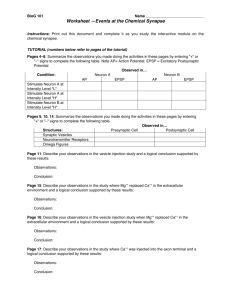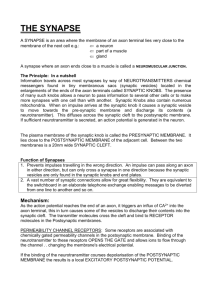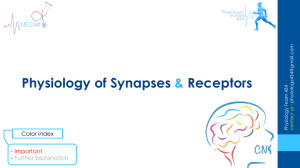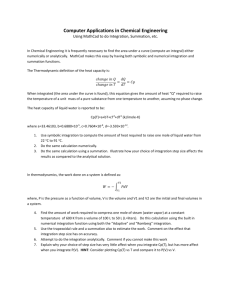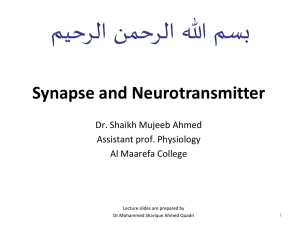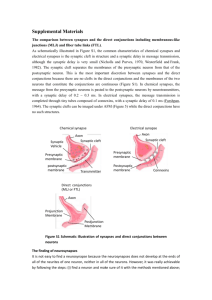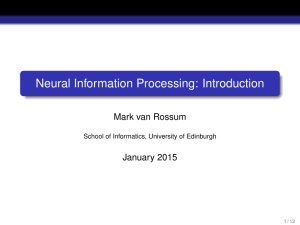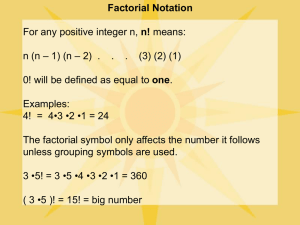nc 03 Calcneurons 1
advertisement
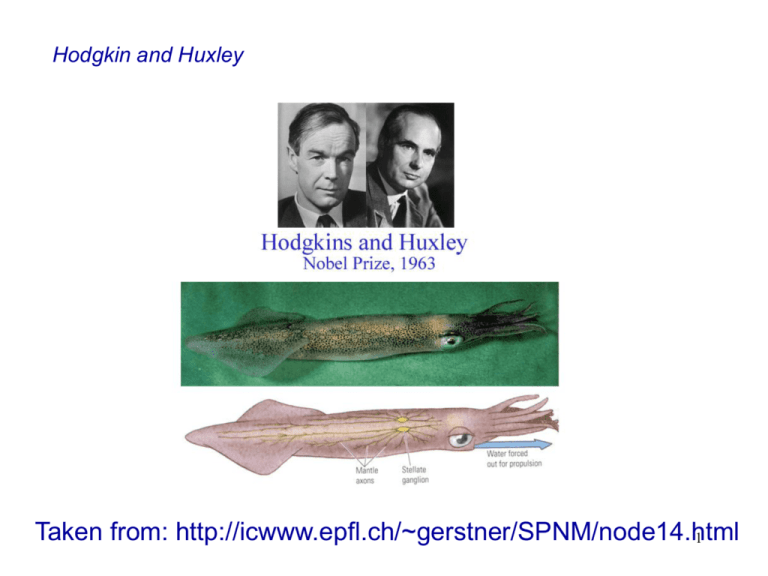
Hodgkin and Huxley Taken from: http://icwww.epfl.ch/~gerstner/SPNM/node14.html 1 Hodgkin Huxley Model: charging current Ion channels I inj (t ) I C (t ) I k (t ) k dVm C I k (t ) I inj (t ) dt k P with Q C u and du dV IC C C dt dt I x g x (Vm Vx ) I k = gNa( Vm à VNa) + gK ( Vm à VK ) + gL ( Vm à VL ) k General Membrane Equation (a very important Equation, used everywhere!) m 2 = à ( à ) à ( à ) à ( à ) + C dV g V V g V V g V V I i nj Na m Na K m K L m L dt Hodgkin Huxley Model: Introducing time-dependence so as to get an Action Potential modelled P I k = gNaf 1( t )( Vm à VNa) + gK f 2( t )( Vm à VK ) + gL f 3( t )( Vm à VL ) k Following Hodgkin and Huxley (using rising AND falling functions): I g Na m h(Vm VNa ) g K n (Vm VK ) g L (Vm VL ) 3 k 4 k Resulting time-dependent Membrane Equation dVm C g Na m 3 h(Vm VNa ) g K n 4 (Vm VK ) g L (Vm VL )3 I inj dt V mV Hodgkin-Huxley Model: Action Potential / Threshold 40 20 0 20 40 60 80 Iinj = 0.42 nA V mV 0 40 20 0 20 40 60 80 10 t ms 15 20 Iinj = 0.43 nA 0 V mV 5 Short, weak current pulses depolarize the cell only a little. 5 40 20 0 20 40 60 80 10 t ms 15 20 Iinj = 0.44 nA An action potential is elicited when crossing the threshold. 0 5 10 t ms 15 20 Action Potential 5 Action Potential 6 Hodgkin Huxley Model: dVm C g Na m 3 h(Vm VNa ) g K n 4 (Vm VK ) g L (Vm VL ) I inj dt • voltage dependent gating variables m m (u )(1 m) m (u )m n n (u )(1 n) n (u )n h (u )(1 h) (u )h h h asymptotic value 1 x [ x x0 (u )] x (u ) time constant with x (u) x0 (u ) [ x (u ) x (u )] (for the giant squid axon) x (u ) [ x (u ) x (u )]1 7 1 x [ x x0 (u )] x (u ) Solution: x = exp(à üt) + x 0 Derivative 1 t ç = à exp(à x ü ü) = à 1 ü exp(à üt) + x 0 à x 0 8 dVm C g Na m 3 h(Vm VNa ) g K n 4 (Vm VK ) g L (Vm VL ) I inj dt 1 x [ x x0 (u )] x (u ) action potential • If u increases, m increases -> Na+ ions flow into the cell • at high u, Na+ conductance shuts off because of h • h reacts slower than m to the voltage increase • K+ conductance, determined by n, slowly increases with increased u 9 Hodgkin Huxley Model: dVm C g Na m 3 h(Vm VNa ) g K n 4 (Vm VK ) g L (Vm VL ) I inj dt Let’s see it in action! HHsim (seminar thema!) 10 Your neurons surely don‘t like this guy! 11 Voltage clamp method • developed 1949 by Kenneth Cole • used in the 1950s by Alan Hodgkin and Andrew Huxley to measure ion current while maintaining specific membrane potentials 12 Voltage clamp method Large depolarization Small depolarization Ic: capacity current Il: leakage current 13 The sodium channel (patch clamp) 14 The sodium channel 15 V mV Hodgkin-Huxley Model: Firing Latency 40 20 0 20 40 60 80 Iinj = 0.45 nA V mV 0 40 20 0 20 40 60 80 10 t ms 15 20 Iinj = 0.65 nA 0 V mV 5 5 40 20 0 20 40 60 80 10 t ms 15 20 Iinj = 0.85 nA 0 5 10 t ms 15 20 A higher current reduces the time until an action potential is elicited. V mV Hodgkin-Huxley Model: Firing Latency 40 20 0 20 40 60 80 Iinj = 0.45 nA V mV 0 40 20 0 20 40 60 80 10 t ms 15 20 Iinj = 0.65 nA 0 V mV 5 5 40 20 0 20 40 60 80 10 t ms 15 20 Iinj = 0.85 nA 0 5 10 t ms 15 20 A higher current reduces the time until an action potential is elicited. Function of the sodium channel 18 V mV Hodgkin-Huxley Model: Refractory Period 40 20 0 20 40 60 80 Iinj = 0.5 nA V mV 0 10 40 20 0 20 40 60 80 15 20 t ms 25 30 Iinj = 0.5 nA 0 V mV 5 5 10 40 20 0 20 40 60 80 15 20 t ms 25 30 Iinj = 0.5 nA 0 5 10 15 20 t ms 25 30 Longer current pulses will lead to more action potentials. However, the next action potential can only occur after a “waiting period” during which the cell return to its normal state. This “waiting period” is called the refractory period. V mV Hodgkin-Huxley Model: Firing Rate 40 20 0 20 40 60 80 Iinj = 0.2 nA V mV 0 40 60 t ms 80 100 Iinj = 0.3 nA 40 20 0 20 40 60 80 When injecting current for longer durations an increase in current strength will lead to an increase of the number of action potentials per time. Thus, the firing rate of the neuron increases. The maximum firing rate is limited by the absolute refractory period. 0 V mV 20 20 40 20 0 20 40 60 80 40 60 t ms 80 100 Iinj = 0.6 nA 0 20 40 60 t ms 80 100 Varying firing properties Rhythmic burst in the absence of synaptic inputs ??? Influence of steady hyperpolarization Influence of the neurotransmitter Acetylcholin 21 Action Potential / Shapes: Squid Giant Axon Rat - Muscle Cat - Heart 22 Propagation of an Action Potential: Action potentials propagate without being diminished (active process). Open channels per mm2 membrane area Local current loops All sites along a nerve fiber will be depolarized until the potential passes threshold. As soon as this happens a new AP will be elicited at some distance to the old one. Main current flow is across the fiber. Time Distance 23 Structure of a Neuron: At the dendrite the incoming signals arrive (incoming currents) At the soma current are finally integrated. At the axon hillock action potential are generated if the potential crosses the membrane threshold The axon transmits (transports) the action potential to distant sites CNS At the synapses are the outgoing signals transmitted onto the dendrites of the target neurons Systems Areas Local Nets Neurons Synapses 24 Molekules Chemical synapse Neurotransmitter Receptors 25 Neurotransmitters Chemicals (amino acids, peptides, monoamines) that transmit, amplify and modulate signals between neuron and another cell. Cause either excitatory or inhibitory PSPs. Glutamate – excitatory transmitter GABA, glycine – inhibitory transmitter 26 Synaptic Transmission: Synapses are used to transmit signals from the axon of a source to the dendrite of a target neuron. There are electrical (rare) and chemical synapses (very common) At an electrical synapse we have direct electrical coupling (e.g., heart muscle cells). At a chemical synapse a chemical substance (transmitter) is used to transport the signal. Electrical synapses operate bi-directional and are extremely fast, chem. syn. operate unidirectional and are slower. Chemical synapses can be excitatory or inhibitory they can enhance or reduce the signal change their synaptic strength (this is what happens during learning). 27 Structure of a Chemical Synapse: Axon Synaptic cleft Motor Endplate (Frog muscle) Active zone vesicles Muscle fiber Presynaptic membrane Postsynaptic membrane Synaptic cleft 28 What happens at a chemical synapse during signal transmission: Pre-synaptic action potential The pre-synaptic action potential depolarises the axon terminals and Ca2+-channels open. Ca2+ enters the pre-synaptic cell by which the transmitter vesicles are forced to open and release the transmitter. Concentration of transmitter in the synaptic cleft Thereby the concentration of transmitter increases in the synaptic cleft and transmitter diffuses to the postsynaptic membrane. Post-synaptic action potential Transmitter sensitive channels at the postsyaptic membrane open. Na+ and Ca2+ enter, K+ leaves the cell. An excitatory postsynaptic current (EPSC) is thereby generated which leads to an excitatory postsynaptic potential (EPSP). 29 Neurotransmitters and their (main) Actions: Transmitter Channel-typ Ion-current Action Acetylecholin nicotin. Receptor Na+ and K+ excitatory Glutamate AMPA / Kainate Na+ and K+ excitatory GABA GABAA-Receptor Cl- inhibitory Cl- inhibitory Glycine Acetylecholin muscarin. Rec. - metabotropic, Ca2+ Release Glutamate NMDA Na+, K+, Ca2+ voltage dependent blocked at resting potential 30 Synaptic Plasticity 31 Structure of a Neuron: At the dendrite the incoming signals arrive (incoming currents) At the soma current are finally integrated. At the axon hillock action potential are generated if the potential crosses the membrane threshold The axon transmits (transports) the action potential to distant sites CNS At the synapses are the outgoing signals transmitted onto the dendrites of the target neurons Systems Areas Local Nets Neurons Synapses 32 Molekules Chemical synapse Neurotransmitter Receptors 33 Neurotransmitters Chemicals (amino acids, peptides, monoamines) that transmit, amplify and modulate signals between neuron and another cell. Cause either excitatory or inhibitory PSPs. Glutamate – excitatory transmitter GABA, glycine – inhibitory transmitter 34 Synaptic Transmission: Synapses are used to transmit signals from the axon of a source to the dendrite of a target neuron. There are electrical (rare) and chemical synapses (very common) At an electrical synapse we have direct electrical coupling (e.g., heart muscle cells). At a chemical synapse a chemical substance (transmitter) is used to transport the signal. Electrical synapses operate bi-directional and are extremely fast, chem. syn. operate unidirectional and are slower. Chemical synapses can be excitatory or inhibitory they can enhance or reduce the signal change their synaptic strength (this is what happens during learning). 35 Simple Computational Operations that can be Performed with Neurons The system to be considered first: One Neuron receiving 2 Synapses. Input 1 Input 2 Soma = CPU Axon = Output What are the computations that can be performed with such a simple system ? First things first: Basic Operations Arithmetical: Locigal + Summation - Subtraction . Multiplication / Division AND OR NOT, etc. More Compex Operations Calculus: Integration dx/dt Differentiation Linear Algebra: Vector Operations 36 y=Ax Matrix Operations Believe it or not: With a single neuron and 2 input you can compute all alrithmetic, many logic and some of the more complex operations ! Required Requisits: Kei ne Ko 1) Resting Potential (ca. -70 mv, constant) 2) Firing Threshold 3) Equilibrium Potential of different ions 4) Time-constants of the ion-channels. gni ti Summation on ohn Transmitter release at a synapse e A leads to an excitatory postsynaptic ddi are opening. potential (EPSP) because ion channels tion mV EPSP rest. pot. t 37 Necessary conditions for optimal summation: 1) synapses have to be closely adjacent 2) pre-synaptic signals have to arrive simultaneously 3) resting potential and reversal potential(s) have to be very different. A B mV EPSP r e s = EPSP + EPSP A B A rest. pot. t B The little “shoulder” shows that the EPSPs were not truely simultaneous. Consider 1: If the synapses are far from each other the amplitude will be less at the first summing point. It will then further decay until reaching the soma. Summation point A mV simultaneous inputs ! B AB Soma Dendrite Spatial Summation EPSP r e s < EPSP + EPSP A rest. pot. t 38 B A B Direction of signal propagation The signal propagates essentially in all directions. The direction towards the soma is (usually) the one which is functionally relevant. Soma A more complicated situation 1) The signal from B arrives later at the summation point because B is farther from it than A. 2) The signal from B is smaller at the summation point (same reason). A Dendrite Soma B incomplete spatial summation EPSPres= a EPSPA + b EPSPB ; b<a<1.0 mV rest. pot. A B How will the signal look like at the summation point ? 39 t Consider 2: If the signals are not simultaneous then the sum will be smaller mV A A B rest. pot. B t The early signal (A) facilitates the later signal (B). Together the firing threshold might be reached but not alone. Temporal Summation mV If the difference in arrival times is too large, temporal summation does not occur anymore ! A B rest. pot. t 40 Consider 3: If the equilibrium potential of the involved ions is close to the resting potential then only incomplete summation is observed. Even a plateau is possible. mV A A B rest. pot. B t The potential of the involved ions can never exceed their own equilibrium potential. (“Clipping”). Conclusion: Summing with neurons is a rather complex process. Spatial and temporal phenomena and the potential levels will influence the result of the “summation” substantially. 41 The same conditions apply as for summation. Then one can regard an IPSP as a sign-inverted EPSP. “Summation” becomes “Subtraction”. 42 Special case: “shunting inhibition” The equilibrium potential of the ions “B” is very close (”indentical”) to the resting potential ! (A is excitatory as usual.) A B mV mV EPSP rest. pot. rest. pot. t (almost) change does no thepotential membrane How potential change ? t When the purple channels are opening (almost) no ion current is obsered and thus the potential stays (almost) the same. - Cl open channel - Cl This case is commonly observed for the Chloride ion. What is the functional significance of this behavior ? 43 Functional significance of “shunting inhibition” Consider the case were Cl-channels are already open when the excitatory channels A are opening and an EPSP is elicited there. Cl to the soma A rite d n De to the peripheral dendrite The EPSP travels to the soma. The membrane potential will be depolarized along the way. A Cl-current is the consequence. The pot. fluctuation (viz. What happens at location Cl positive with themembrane relation between EPSP) willmembrane be immediately compensated for. Thus, at the open Cl channels potential and Cl-equilibrium potential ? no more depolarization is observed. The EPSP is electrically shunted ! 44 45 The physiological transmitter is Glutamate (Glu). out in out in 46 47 48

